Discover Scotland’s Historic Bricks and Tiles
Architecture, Materials | Written by: Moses Jenkins | Tuesday 28 May 2024
Fired earth products such as bricks and tiles have contributed to Scotland’s buildings for centuries. In this blog, our Project Manager Dr Moses Jenkins reveals the historical use of these materials, and discusses their repair and conservation.
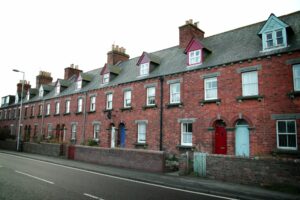
Brick housing can be seen in a number of areas of Scotland such as here in Brora.
Scotland’s brick built heritage
Scotland has a rich heritage of traditionally constructed brickwork. Fired clay bricks have been used to construct a wide variety of buildings, including lighthouses, schools, churches, industrial buildings, and domestic properties.
Traditionally constructed brickwork can be found dating from the 18th, 19th and into the 20th century. Although construction techniques evolved in the 20th century, it continues to be used today and our existing heritage of buildings built of brick are a valuable and sustainable resource.
Other fired clay products used in Scottish traditional construction include tiles – both flat, as well as pantiles – on roofs; floor tiles, and terracotta and faience which have been used to create a decorative effect in a number of Scottish buildings.
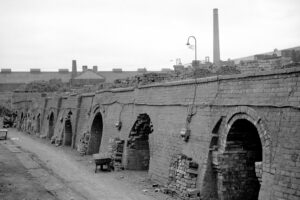
Brickworks were once common throughout Scotland, this is the Frankfield Brickworks, Glasgow, showing the front of the kilns. The brickworks closed in 1970 and has since been demolished.
Types of Brick in Scotland
A number of different types of brick are utilised in traditional Scottish brickwork. In the 18th and first half of the 19th century, handmade bricks were used. These can be seen in structures such as Stanley Mills in Perthshire.
As technology advanced in the mid-to-late 19th century, new types of brick began to be used. These could be produced by extrusion, which was an early method of mechanically moulding bricks.
Pressed facing bricks also began to be used in the late 19th century. These are highly durable, giving a distinctly smooth appearance to a building façade.
The use of colliery shale to make what were termed ‘common’ or ‘colliery’ bricks also emerges around this time. Such bricks were produced in vast quantities throughout Central Scotland and are frequently seen in buildings today.
Glazed bricks were produced in a number of Scottish brickworks and came in a range of colours. Each type of brick has its own particular material properties, which need to be considered when looking at repair and maintenance.
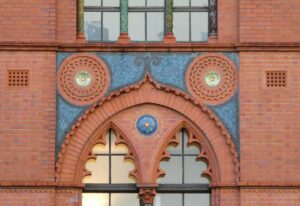
Close-up of the Templeton Carpet Factory on Glasgow Green, designed by the architect William Leiper (1839-1916).
Repair and maintenance
There are a number of straightforward maintenance tasks that can help avoid the decay of brickwork. Ensuring gutters, downpipes, and surface drainage are all functioning correctly will help to keep brickwork free from excess water.
When repairs are needed, these should be carried out in a timely fashion. Mortar joints in brickwork will need repointed periodically over its lifetime. This means that the mortar joints, when they are beginning to decay, require to be raked out and repointed with a matching mortar.
Where brickwork is suffering from specific problems – such as those caused by salts or biological growth – the cause of these should be identified and fixed prior to repair work taking place.
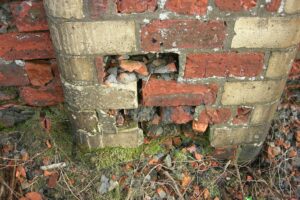
Where brick has suffered decay a careful assessment should be made before repairs.
Where decay has occurred to bricks, they may need to be removed and replaced if they are no longer fulfilling their purpose in the wall, although this should be carefully evaluated and replacement work only undertaken when necessary.
When sourcing replacement bricks for repair work, there are a number of important considerations. As far as possible, the type, size, colour, and technical performance of the bricks should match the originals. In some cases, it may be possible to use reclaimed brick, but the source of this should be carefully considered in order to ensure that the bricks are durable enough for use externally.
Guidance on repair and maintenance can be found in our Historic Environment Scotland short guide: Repairing Traditional Brickwork.
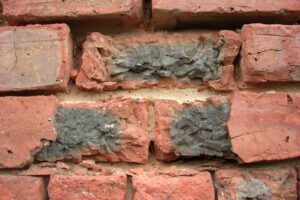
Where brick has suffered decay a careful assessment should be made before repairs.
Traditional Brick buildings: a sustainable resource
Scottish brick buildings have proven to be durable and adaptable, embodying sustainability and the circular economy.
In the past buildings such as Stanley Mills and Anchor Mill, Paisley have been converted to housing. More recently, the Rosebank Distillery in Falkirk has been brought back into use and Shrubhill Tramway Workshops have also been converted.
With ambitious plans to transform the former Pipe Factory in Bain Street, Glasgow and the Glebe Sugar Refinery in Greenock, Scottish brick buildings are demonstrating their adaptability and are a sustainable resource for the future.
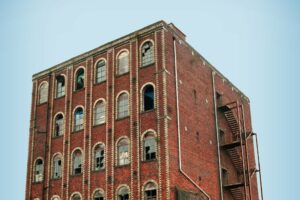
Brick buildings are adaptable and sustainable, a number have been brought back into use recently with the Glebe Sugar Refinery, Greenock one of a number of planned adaptations.
An exceptional part of our heritage
Scotland has many excellent examples of traditionally constructed brick buildings. From the iconic Templeton’s Carpet Factory in Glasgow to windswept North Unst lighthouse and countless other examples, brickwork is an important part of our built heritage.
These are an adaptable, durable, and sustainable resource. With careful repair and maintenance, Scotland’s traditional brick buildings will continue to provide a valuable resource well into the future.
Why not let us know what your favourite example of traditionally constructed brick buildings is in Scotland?
About the author:
Moses Jenkins
Dr Moses Jenkins is a Project Manager at HES. He is the author of a number of technical advice documents, including the HES Guide to Energy Retrofit and the book Survey and Assessment of Traditionally Constructed Brickwork.
View all posts by Moses Jenkins



